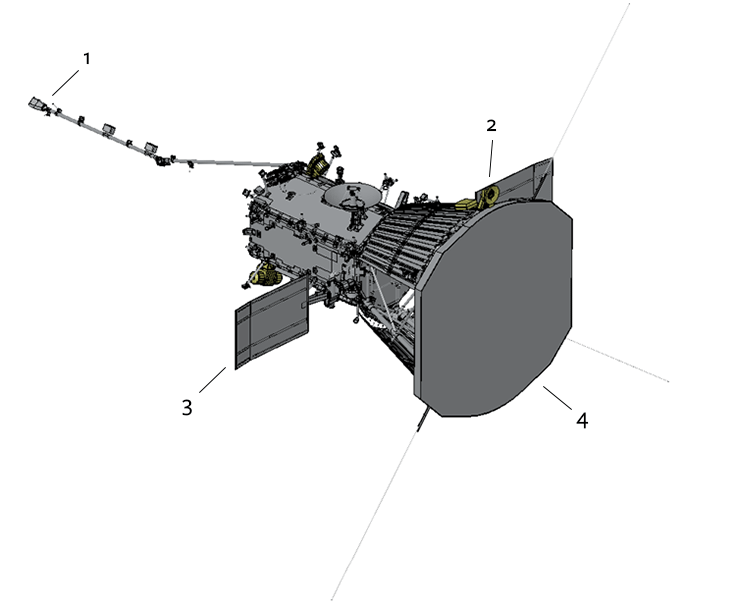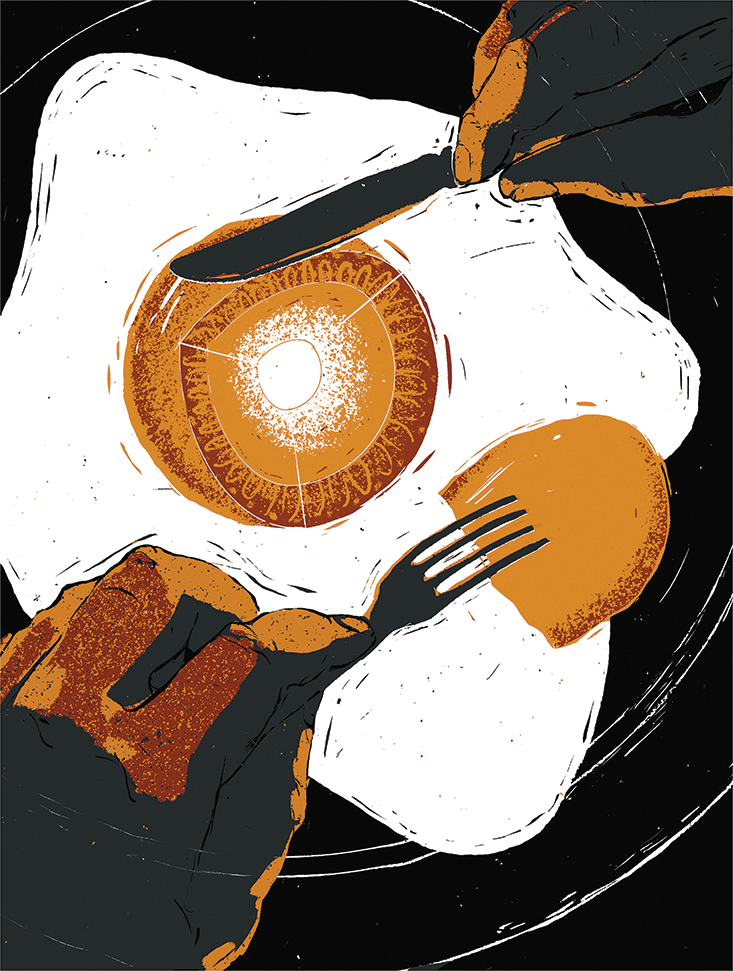When Justin Kasper, a professor of space physics at the University of Michigan, daydreams, he visualizes a spacecraft the size of a Toyota Prius speeding through the sun’s corona—a cloud of superheated plasma. The vessel, NASA’s Solar Probe Plus, will be closer to our star than any manmade object has ever been—only 4 million miles from its surface. There, the sun shines 512 times brighter and is 20 times wider than what we see on earth. Flying at 450,000 miles per hour, the Solar Probe will be the fastest thing we have ever put into space, and the toughest one too—its 4.5-inch-thick carbon foam heat shield, sandwiched between carbon plates, can withstand temperatures of 2,500 degrees Fahrenheit. Operating at around room temperature beneath this shield are computers and other equipment controlling the craft’s path. But the probe’s most important instrument, its Faraday cup, sits outside the shield like a figurehead on a schooner, dipping into the solar wind—a million-mile-an-hour blast of electrons, protons, and helium ions. The size of a tuna can, this cup will record the wind’s composition and direction. The results of its measurements could answer certain outstanding puzzles of astrophysics, key among which is the mystery of why the sun’s corona is hotter than its surface. And understanding the solar wind better may help humans colonize space.
The solar wind is both protective and dangerous. On one hand, it helps create the safe harbor that is our solar system—it protects us from the destructive cosmic rays emanating from the distant supernovas, much like a headland protects a bay from big ocean waves. On the other hand, it can slam massive clouds of charged particles against the earth’s magnetic field, “causing the global bubble of magnetism that surrounds our planet to shake and quiver,” says one NASA site. These storms generate tremendous electrical currents, which can greatly disrupt life on earth. During the famous 1859 solar storm, known as the Carrington Event, telegraph systems across Europe and North America failed, sparks gave operators electric shocks, and telegraph paper caught fire. In today’s world, highly dependent on satellite-to-ground communications, GPS signals, and cell phone connections, a similar electromagnetic storm can wreak havoc of a much greater degree. It is dangerous for space travel, too, interfering with equipment and irradiating astronauts and ships. While NASA has landed humans on the moon and rovers on Mars, sampled the Venusian atmosphere, and crashed a probe into Comet Tempel 1, the sun and its wind remain something of a mystery. With the Solar Probe Plus, the least explored object in our solar system will at last get a close-up.
The sun is made of layers: From the inside out, they are the core, photosphere, chromosphere, and corona. The core is a dense cloud of hydrogen ions undergoing continuous nuclear fusion reactions, which create helium ions and release tremendous amounts of heat and energy that radiate out to the photosphere. The sun’s core is 27 million degrees Fahrenheit, but the photosphere is 10,000 degrees Fahrenheit—only about five times hotter than the hottest forest fires. This makes sense—the farther away from a campfire you sit, the colder it gets. But the sun is not as simple. Beyond the photosphere is a relatively thin layer of the chromosphere, where the solar wind is thought to originate. Farther out is the corona, which is several million miles thick and as hot as 5 million degrees Fahrenheit. In the corona, the campfire analogy fails—it gets hotter farther away from the sun’s core.
Jonathan Cirtain, who led a team at NASA’s Marshall Space Flight Center in Huntsville, Alabama in creating part of the Solar Probe cup, believes that the sun’s magnetic energy is responsible for the corona’s heat. Stored in the upper parts of the chromosphere or lower parts of the corona, this magnetic energy is being released into the plasma. That heats up the plasma to such a degree that particles escape the sun’s gravity and shoot out at 1 million miles per hour in a form of the solar wind. As the Solar Probe Plus speeds through the corona, this wind will blow right into Kasper’s and Cirtain’s cup.

The tough little cup is made of highly heat-resistant metals—molybdenum, titanium, and zirconium. Two sheets of niobium, an even more heat-resistant metal, will cover the cup’s opening, which will dip into the wind. Each sheet will have a small hole for particles to fly into. Once inside, the particles will pass through a series of tungsten grids, which are primed to specific voltages and act as filters. “By measuring the current as a function of voltage I can separately see the protons and the alphas, since they require different voltages to stop them,” says Kasper. “With the current as a function of voltage I get the basic properties of the wind: density, velocity, and temperature.” Once they pass through the grids, the particles will impact against a circular metal plate that will record their charge and the angle at which they come in. The angle is important, Kasper explains, because the plasma may slosh back and forth. “The way the flow changes when the electric field and magnetic field change tells us a lot about what kind of wave or eddy we are passing through, and if it is heading toward the sun or away.”
The Solar Probe Plus’ Faraday cup must be among the most abused—and tested—containers mankind has made. A powerful particle accelerator at NASA’s Marshall Space Flight Center blasted the cup with ions and electrons at energies similar to those in the solar wind. At a solar furnace in the French Pyrenees, the cup withstood a sunray beam that can burn a foot-wide hole through a steel plate in 30 seconds. The cup also faced a row of IMAX movie projectors, whose xenon bulbs emit ultraviolet light at the same spectrum as the sun’s surface. How did it fare? “I am pleased to say,” says Kasper, “the cup is doing quite well.”
Understanding the solar wind better may help humans colonize space.
Kasper’s daydream will become reality 10 years from now, after NASA launches its probe in 2018. Using the gravitational tug of Venus as a gigantic break pad, the probe will drop into an orbit that will take it closer to the sun. Three months after liftoff, in July 2018, the probe will make the first of its 24 solar approaches. On each approach the probe will have an 11-day window to dip into the sun, during which a wide-field telescope will image the corona and the cup will harness solar wind.
During its solar dip, the probe won’t be able to communicate with Earth for a variety of reasons: the risk of the antennae getting scorched, magnetic interference, plus the sun will, at times, stand between the probe and the earth. But on its way back to Venus, the probe will use the sun’s energy to transmit the data it gathered, informing Kasper and Cirtain about the wind’s origin, composition, and intensity.
“The discoveries that will be made are off the charts,” says NASA astrophysicist Madhulika Guhathakurta, who heads NASA’s “Living With a Star” program. Elon Musk’s project to populate Mars, NASA’s initiative to fly to Europa, and other future space missions may use this information to escape the at times violent storm of particles hurling from the sun. “This could be the mission that helps the human species go from earth dwellers to space dwellers,” Guhathakurta says.
Justin Nobel’s stories about science and culture have appeared in Time, Orion, and Tin House. Among other projects, he is currently working on a book of tales about the weather. He lives in New Orleans.




























